Strange Things Happening Underground
As a horizontal environmental well drilling contractor, we appreciate the chance to work on exciting projects that extend horizontal directional drilling (HDD) technology, push the boundaries of the feasible, or are just plain interesting. Once underway on such a project, however, it’s best if the work proceeds in a straightforward, maybe even in boring (pun intended) way. We can do without the excitement of equipment failures, unmarked utilities, or unexpected ground conditions. But horizontal drilling is still drilling, and strange things can occur. Looking back over the years, here are some of the oddest occurrences that we’ve experienced or seen on horizontal well projects.
- One muddy truck!
While installing a thermally-enhanced horizontal vapor extraction system in New Mexico, we witnessed the results of “directional” drilling gone awry. A contractor in an excavation was installing soil nails to stabilize the excavation wall. They were using an excavator to push drill rods into the soil while pumping drilling fluid to assist with the drilling and to clean the borehole. Once the hole was drilled, a steel bar is inserted and grouted in place (hench the term soil nail). This type of “directional” drilling doesn’t use an eccentric bit to steer and guidance tooling for locating, it’s basically just pushing drill pipe into the excavation wall or slope. (look closely at the photos and you see just a drill pipe and “bit”, no duckbill bit or sonde housing).
This site was very cobbly, and as the excavator pushed the rods, a cobble deflected the drill string upward and out of the ground surface past the edge of the excavation. Unfortunately, one of the city’s building inspectors was on site to look over some other part of the construction project. He returned to his nearly new Dodge Dakota pickup to find it skewered! The drill string exited the ground, punctured the floorboard, advanced through the truck, and exited the driver’s side door. To add insult to injury, the driller didn’t shut off the mud flow when the mud returns stopped, so the interior of the pickup received a mud bath. When the inspector arrived on scene, the bit was still hanging in space spewing a cyclone of bentonite.
This happened several years ago, and we still get a chuckle out of it (particularly since it didn’t happen to us!)
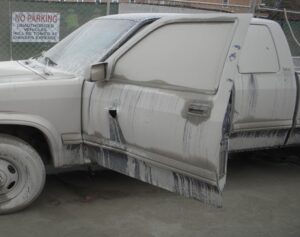
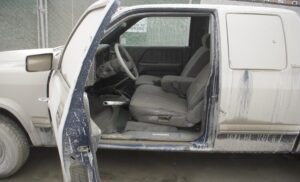
- Odd stuff in landfills.
We have drilled in or under several landfills to install leachate drains, storm water conveyances, or other infrastructure. Drilling in a landfill is never dull and often stinky – you never can predict what you’ll drill into, and invariably something will plug up the bit and require a trip out to unplug it. We’ve had a discarded basketball stuck on a drill bit, and we almost always wind up what seems to be a half-mile of wire on any landfill job.
One of the oddest things we’ve encountered was a magnetic anomaly detected by our drill bit navigation system, just before we solidly collided with something big, unmovable, and ferrous, deep in landfill. We speculated that its origin went something like this:
Mechanic: “Hey boss, we got that engine swapped out in compactor #4. What do you want to do with the old engine block?”
Boss: “Oh, just dump it in the landfill, no sense in hauling it anywhere….”
Well, we found it if you’re looking for it! In that same bore we noticed extra torque building up on our drill string as we pre-reamed the bore prior to pulling back the well materials. When the reaming bit exited the bore it was wrapped in polyethylene bags, filled with what appeared to be asbestos insulation.
If you’re looking for your lost asbestos, we found that too!
- Rebar – not just for reinforcing concrete.
Many years ago, there was a horizontal well company named Drilex. While installing wells at an industrial facility in Louisiana, the driller noticed the torque was increasing dramatically as the bit neared the exit of a continuous bore. Finally, the superintendent told the driller to stop rotating and just push the bit out of the ground for the last four feet. What they found was about two feet of rebar wrapped around the drill pipe, kind of looked like a snake…
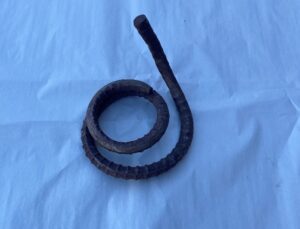
- Vertical drillers have problems too.
And just to prove that problems occur in vertical drilling too – which bit below is the new one and which ran too long in a cobble formation? Just as an FYI, fishing for lost cones off a tricone bit is difficult in a vertical hole, virtually impossible in a horizontal bore.

- Where is the screen in the vertical piezometer?
Many of the sites we work on are filled with abandoned soil borings and existing wells. We try to avoid drilling within 5’ or so of screens in existing wells. But if the well completion report says the screen starts at 25’ deep we need to know if that elevation is below top of casing, below existing ground surface or relative to mean sea level. If we don’t know the exact depth location of the screen and we drill too close, it’s possible for the drilling fluid to migrate up the vertical well to the surface. Not a disaster, but the vertical well certainly needs to be re-developed.

- More vertical challenges.
We’re always concerned with “fracking out” (losing drilling fluid to the ground surface) while drilling beneath ditches, streams, and other depressions in the ground. So much so on this site we had a pallet of sandbags near the bore path to dam the concrete lined storm water ditch. The facility owner gave us the OK to create a small lake of drilling fluid if we fracked out in the shallow channel. Well, we did lose drilling fluid to the ground surface, not in the ditch but along the pathway created by the power pole guy wire. We’re still trying to figure this one out.
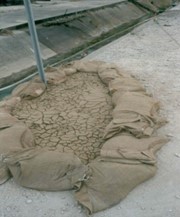
- Finally – sometimes we miss the forest for the trees.
Almost all the time we (owners, consultants, drillers) do a fantastic job in locating utilities. However things can go very, very wrong. The photo below has been floating around for at least 15 years and we’re not even sure how we have it. In this case all the utilities were located, but somehow an underground pedestrian walkway was not identified, and the HDD driller harpooned the walkway. Over the years we’ve heard various stories on where this OOPS occurred, but as in many urban legends, we haven’t found anyone who was there (or will admit to being there).
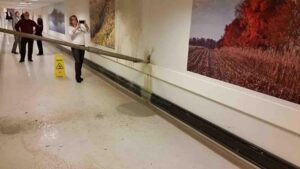
Well there you have it, proof that all horizontal drilling projects go perfectly. While we’re many times pushing the envelope of horizontal environmental wells, sometimes things can go slightly wrong. One of the reasons we spend so much time on project coordination before we head to the field is to try and identify potential problems. However when things go awry, it’s best to have a project team that’s flexible and works on solutions, not attempting to fix blame. We hope our years of experience give you the confidence to call us when thinking about horizontal wells to solve the problem at your site.